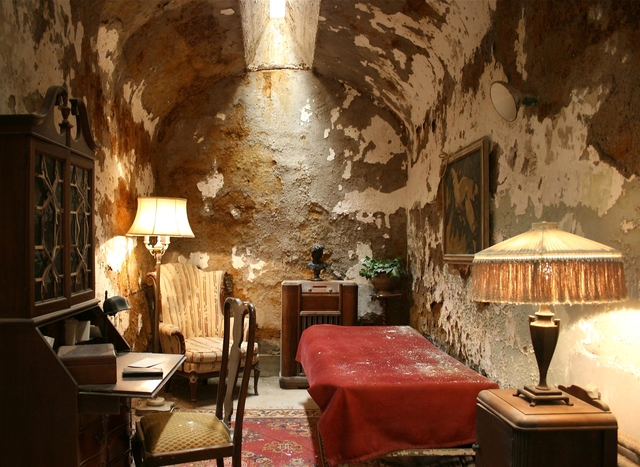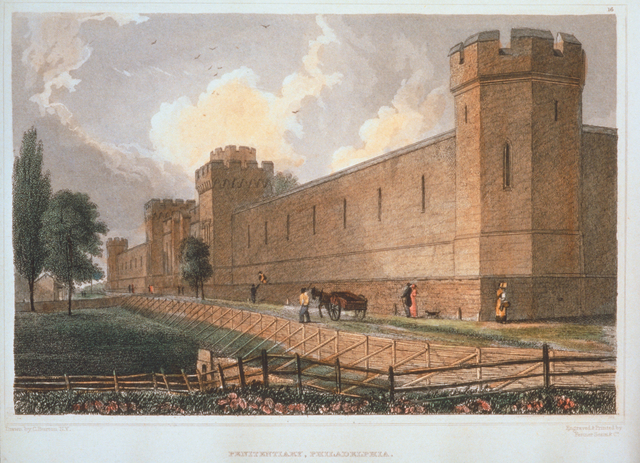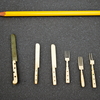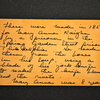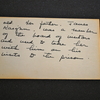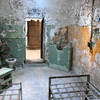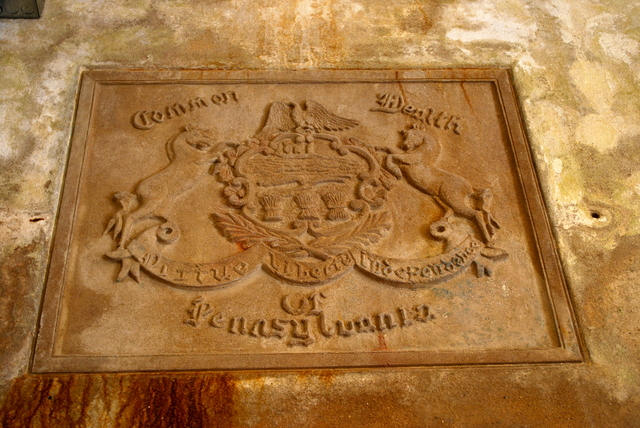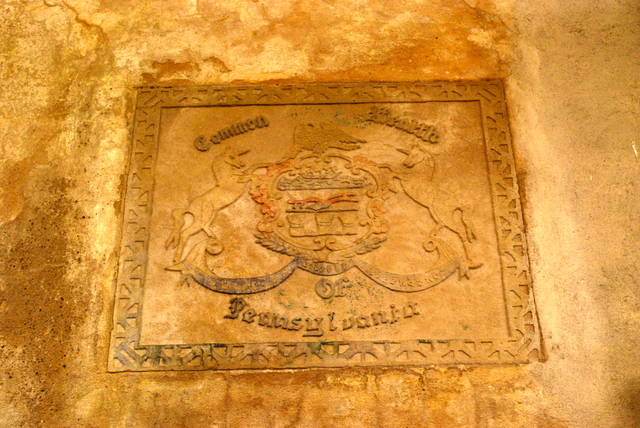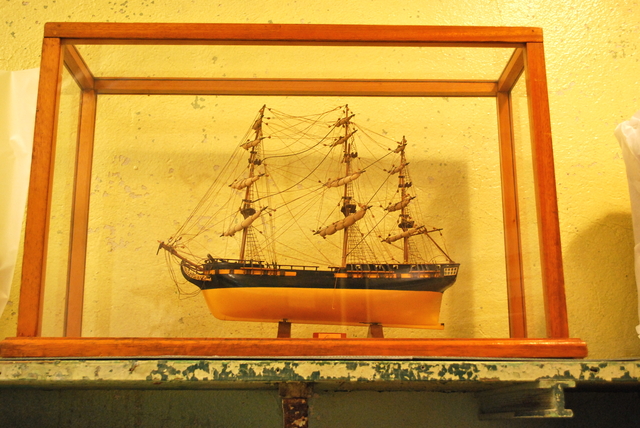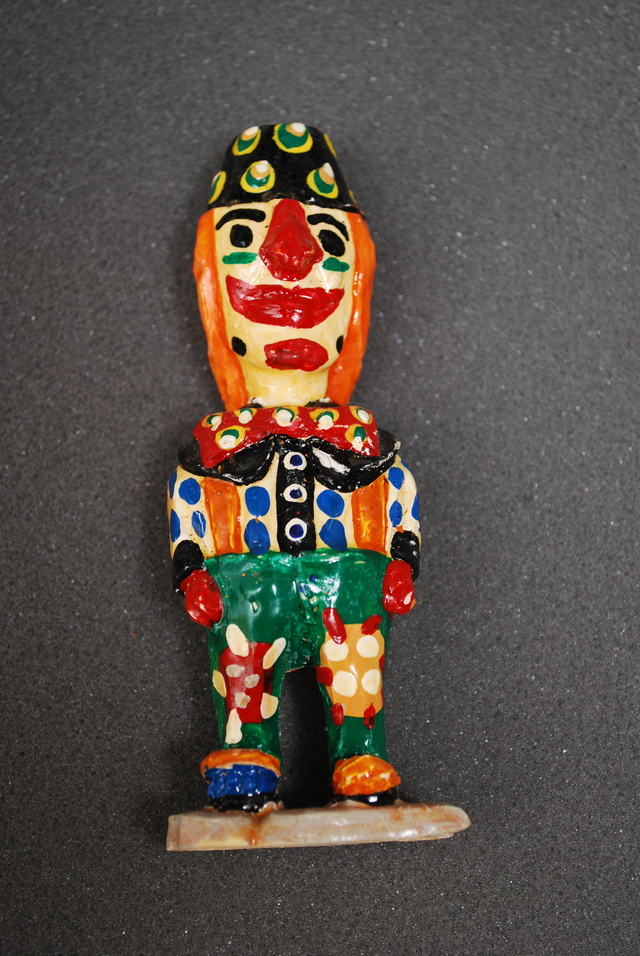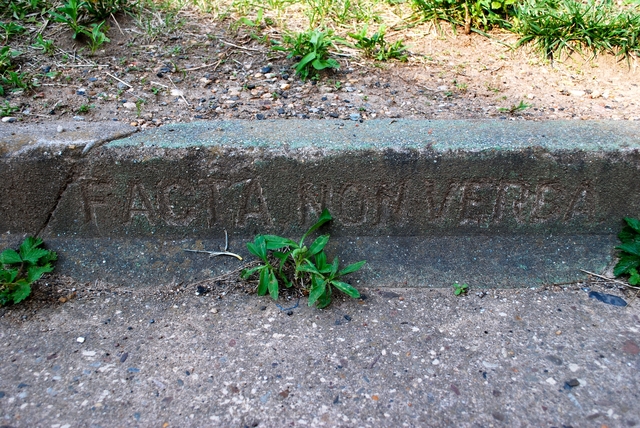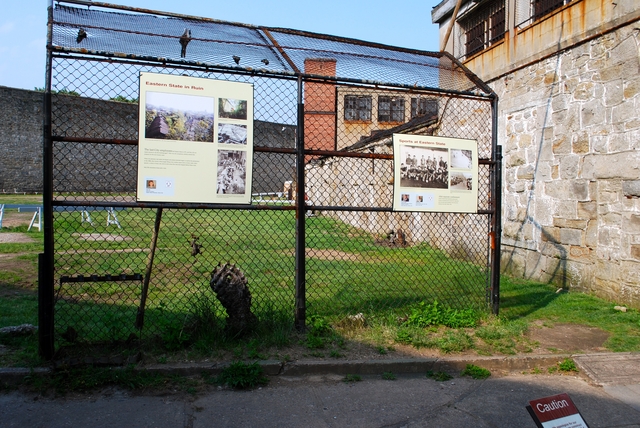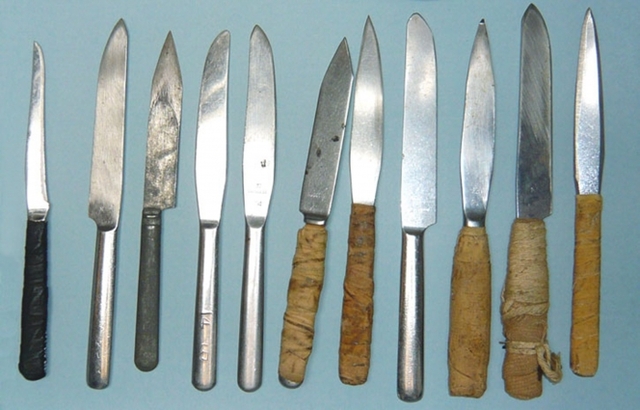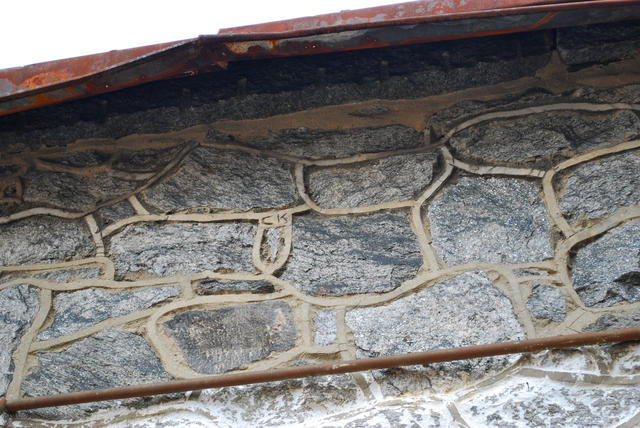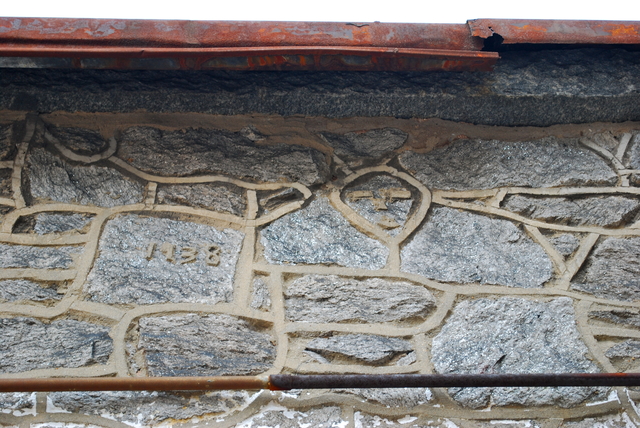The Prison Palimpsest: A Former Tour Guide Looks Back at Eastern State Penitentiary
At work we notice a mummified cat. It rests in a pile of paint chips and splintered wood in the wreck of the prison warden’s quarters. The other tour guides and I venture across floorboards to marvel at it, a husk of skin rippling over tendons and ribs.
We are here, and the cat is here, because more than 200 years ago, a group of Philadelphian reformers had a utopian vision of how prisons should be run. They designed a new penal system based on the principle of separate confinement: the isolation of prisoners from the outside world and from each other. In 1829 they opened Eastern State Penitentiary to put their ideas into practice. Nothing turned out the way they had intended, and today the prison survives in a state of ruin as a heritage site. Clues as to how the system unraveled are written into the structure itself, in the off-kilter rays of cellblocks, in shivs turned up in moldering cells, in tunnels dug by would-be escapees. The palimpsest is legible to those who care to read it. It tells a story of ideals chipped away over time, the death of a dream.
The first prisoner arrived at Eastern State Penitentiary on October 25, 1829. A young African-American man from Harrisburg, Charles Williams had come to serve two years for burglary.
What thoughts crossed Williams’s mind as he caught sight of the penitentiary’s gothic, castle-like facade, a structure described as “grave, severe, and awful”? He entered through its only door to the outside world, an oaken gate with iron rivets that weighed several tons and was said to be “the most imposing in the United States.” Once inside, Williams submitted to an inspection: the prison clerk jotted down such details as his complexion, stature, and the length of his feet. Williams then received his plain prison garb and a new identification: Prisoner #1. Before escorting him to his cell, a staff member drew a hood over his head, the better to confuse any later escape attempts.
Prisoner #1 found himself in a locked room designed to minimize his contact with other people. He received meals of mush, meat, and potatoes through a slot in one wall; sun through a small skylight called the “dead eye”; and exercise in his own little walled yard. In an era when the White House lacked running water, Prisoner #1 had a toilet and a tap. A few approved visitors stopped by from time to time—the warden, a clergyman, a craftsman to teach him the honest trade of shoe-making—but according to the rules, he would never meet another prisoner, nor would he receive letters or visits from anyone back home.
Other men and women soon followed Prisoner #1 through the medieval portcullis, convicted of horse-stealing, highway robbery, forgery, murder, and other crimes. Filed away in their own blank cells, they were intended to serve their sentences in a state of “deep reflection and penitential sorrow, leading to a moral change.”
The experiment began.
A handwritten note found with this miniature cutlery set reads: “These were made in 1856 for Mary Anna Kaighn by a prisoner in the Spring Garden Street Prison, Philadelphia. He made them from the bones in his soup using a blade of his jack knife to make the knife blade and the rivets. Mary Anna was 8 years old. Her father, James Kaighn, was a member of the board of visitors and used to take her with him on his visits to the prison.”
To understand how the idea of imprisoning convicts alone in their own cells for years came to seem so revolutionary, one must consider the jailhouses that came before. Eighteenth-century American jails served as holding tanks for convicts as they awaited trial. As reformers described it, these jails mixed men, women, and very young offenders into “one corrupting mass of shameless iniquity … He who entered their gates a novice in guilt, accomplished his education in villany.” Jail time itself was not the actual punishment. Punishment for crime tended to involve pain and public humiliation, inflicted via the whip, the brand, or the pillory.
In the view of Philadelphia’s prison reformers, this system of depraved jails and harsh penalties did little to reduce crime. If anything, it prevented convicts from pursuing honest livelihoods. Known to the community at large, the convicts faced stigma. Known to each other, they faced corruption and blackmail. The reformers believed that the old punishments should be replaced with humane and rehabilitative “solitary confinement at labour, with instruction in labour, in morals, and in religion.”
In 1787 Benjamin Rush and other civic leaders established the Philadelphia Society for Alleviating the Miseries of Public Prisons, the group that went on to build Eastern State. Their Quaker-influenced penal concept came to be known as the Pennsylvania System, defined by the principle of isolation. Isolation punished prisoners nonviolently, forcing them to reflect on their crimes with “salutary anguish and remorse.” The penitentiary itself represented a total environment in which prisoners’ lives might be controlled, their behavior modified, and their entire outlook transformed.
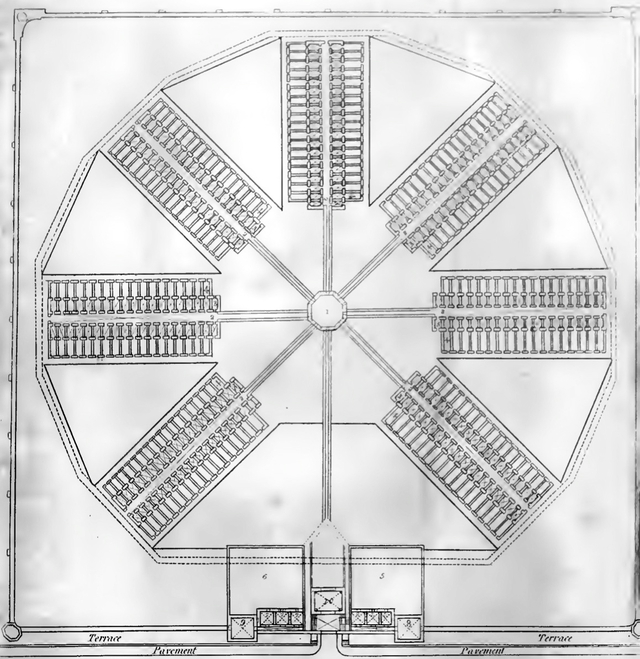
Symmetrical design for the radial plan. C.G. Childs, A View and Description of the Eastern Penitentiary of Pennsylvania, 1830
Eastern State’s architecture reflected the reformers’ high hopes. Charged with giving physical shape to the Pennsylvania System, architect John Haviland proposed a radial plan of seven cellblocks spanning from a central rotunda. A single guard standing in the center could watch over every corridor. Haviland also infused the prison with church-like decorative flourishes: barrel vaults, turrets, and cast iron balusters.
Visitors from elsewhere marveled at the penitentiary, one of the most ambitious public buildings in America at the time. Ultimately more than 300 prisons around the world would replicate its radial design. Eastern State’s success became a matter of pride for Pennsylvanians and the young republic. Even the wagons that carried meals to each cell came loaded with notions of post-Revolutionary national pride, bearing the nicknames Franklin, Washington, and Lafayette. As a state report put it, the Pennsylvania System, as embodied in Eastern State, was “identified with our national honor and reputation” and commanded “the admiration of the whole civilized world.”
Today people still throng to Eastern State: families, school groups, wedding parties, indie rock bands shooting music videos. During my season as a tour guide, every day brought some novel assignment. We tidied Al Capone’s cell, collected bugs for a visiting entomologist, and hurled hundreds of Tastycakes over the ramparts for the Bastille Day celebration.
I loved the job, and in slow twilight hours I perched in a tour guide stand, falling into a kind of meditative trance. I considered the prison guards who once stood there and the strange historical process through which tour guides supplanted them. Vines rustled in the wind and shadows crept across walls.
On a few occasions I spent all night in the prison, escorting groups of paranormal investigators. They appreciated the picturesque quality of the ruins, the bats swarming above, and the thrill of exploration. Some took a technological approach, setting up camp with an arsenal of gadgets. Others preferred seances by candlelight. A few ran screaming through the cellblocks, cursing the spirits. One night I met an actual parapsychologist, a man in a black trench coat who said he worked with the Catholic Church. “Not everyone is cut out for spiritual demonology,” he told me.
I believe the prison is haunted, perhaps not by distinct ghosts one could hunt with an Electronic Voice Phenomena detector, but by the aura of the tens of thousands of lives it held captive. The prisoners have left traces throughout the penitentiary, embellishing Haviland’s design with their own mysterious marks.
In Cellblock 8 we find an eye painted over a doorway. Guards long permitted inmates to paint their cells at Eastern State. When Charles Dickens visited in 1842, he met two prisoners who decorated their walls using colors extracted from yarn.
These two Pennsylvania state seals are on the walls of the former intake area. Notice anything unusual about the one on the right?
The historic site collects the handiworks of prisoners. Here we have a model ship and a clown made out of soap.
In the penitentiary’s early days, when the guards wished to punish Prisoner #50, a “notorious robber,” for idling, they removed all books and tools from his cell. He soon begged for the chance to labor: “For G—’s sake, give me a book or some work, or I shall die!” Three weeks passed, and when at last he received his tools again, he “pursued his work with unusual industry, and never after gave cause of complaint.”
This episode illustrates how things were supposed to work at Eastern State. No one got flogged, and a robber now appeared to value legitimate labor.
But behind the walls and out of sight, the prison’s first warden, Samuel Wood, sometimes enforced a more violent system of discipline. Unruly prisoners could find themselves starved, confined in straitjackets, stripped nude and doused with cold water outdoors on winter days, strapped to the “mad chair,” or bashed over the head with wooden boards. Worst of all, inmate Matthias Maccumsey died of “apoplexy” after guards restrained him with an iron gag. Warden Wood had Maccumsey’s bruised and bloodied body carried out of the prison as night fell. The coroner conducted no inquest, and Wood advised the guards involved to “keep their own secrets.”
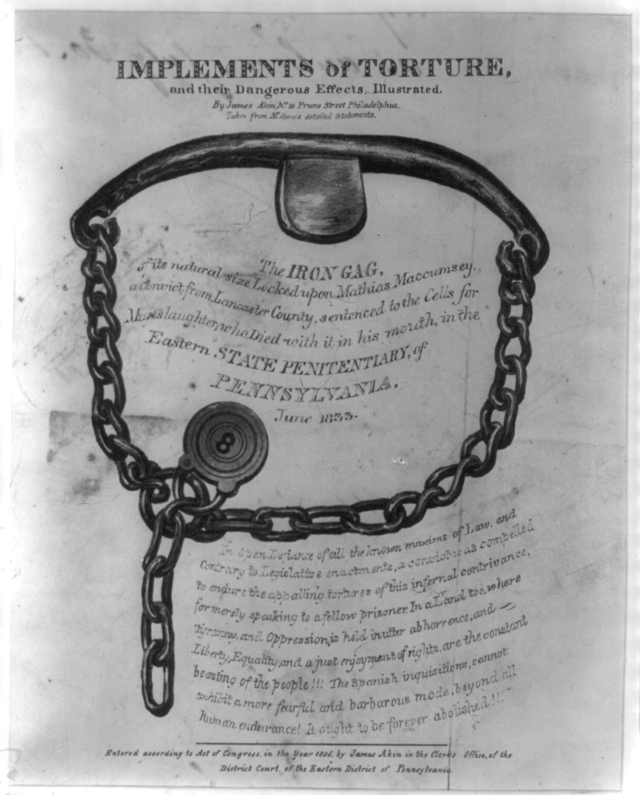
An illustration of the iron gag used on Matthias Maccumsey. James Akin, c. 1835. Library of Congress
The text below the previous illustration reads: “In Open Defiance of all the known maxims of Law, and contrary to Legislative enactments, a convict was compelled to endure the appalling tortures of this infernal contrivance, for merely speaking to a fellow prisoner. In a Land too, where Tyranny and Oppression, is held in utter abhorrence, and—Liberty, Equality, and a just enjoyment of rights are the constant boasting of the people!!! The Spanish inquisitions cannot exhibit a more fearful and barbarous mode beyond all human endurance! It ought to be forever abolished!!!”
They didn’t. The Maccumsey story and other tales of cruelty, corruption, and debauchery began to seep out in 1834. Witnesses described a full range of “licentious and immoral” practices at the prison quite at odds with its monasterial image. A report by state legislator Thomas McElwee documented a government inquiry into these affairs, exposing the wide gap between theory and practice of the Pennsylvania System.
For matters of lewdness, the state found an ideal scapegoat: Mrs. Blundin. Little is known of Mrs. Blundin beyond her bawdy reign at the penitentiary, not even her first name, which never appears in the lengthy testimony that concerns her. She arrived with her husband Richard, who worked at the penitentiary as an underkeeper. While not officially on Eastern State’s payroll, she wormed her way into its operations, gaining access to the stores of food and drink.
For starters, Mrs. Blundin stole massive amounts of prison food. “Potatoes, bread, molasses, soap, chests of tea, coffee, rice, cream, pork, and beef disappeared, sometimes resulting in no meat for the prisoners,” wrote historian Norman Johnston in his examination of this affair.
Mrs. Blundin also liked to party, holding “quilting frolics” with feasting, drinking, and dancing inside the prison for as many as forty guests. She employed male and female prisoners as waitstaff for these entertainments, and afterward the inmates could be seen wandering around the prison, intoxicated and lost. Mrs. Blundin herself sometimes started drinking before work in the morning and could be observed stumbling in a drunken daze.
Defying all nineteenth-century standards of respectability, Mrs. Blundin appears to have sought pleasure in the arms of different men at Eastern State. She was observed lingering behind bedroom doors with the prison clerk and the carriage driver. She also made “lascivious overtures” to a prisoner and offered him advice on how to escape. Prisoners complained of having to wash the Blundin family’s laundry, stained as it was with the signs of venereal disease.
As for Warden Samuel Wood’s authority over the penitentiary, Mrs. Blundin seems to have had little respect for it:
[The hearings] revealed that one day, under the influence, [Mrs. Blundin] told one inmate concerning the warden, “she would go up to the Centre house and flog that damn Quaker son of a bitch!” When she returned, she told the inmate that she had had an argument with the warden, calling him a liar, and that he had said if she were not quiet he would slap her face, whereupon she told him to kiss her arse, and that she would knock every tooth down his throat, break every pane of glass in the Center house, and then run out and holloa murder.
Why did Warden Wood permit Mrs. Blundin to upend the Pennsylvania System with her profane and intemperate ways? As Johnston has hypothesized, the pair seem to have shared a tumultuous and possibly adulterous relationship. Witnesses observed them in suggestive situations: talking intimately, “making signs,” and retreating alone together to an empty building within the penitentiary. Said one witness: “On one occasion from the breakfast table they went to his bedroom for half an hour with the door shut.”
One reading the report cannot help but note that a number of prisoners spent significant time out of their cells. Warden Wood and Mrs. Blundin pulled inmates into personal service, laundry, and kitchen work, and in these situations the prisoners had the opportunity to interact with each other. It is also worth noting that the scandals came to light before builders had even finished constructing the final cellblock. After all the time and money spent conceptualizing and building the Pennsylvania System, Wood had failed to implement it in its pure form.
Despite the evidence against him, Warden Wood weathered the investigation and kept his place at the prison. For the Commonwealth of Pennsylvania, Eastern State was a project too big to fail. The committee of legislators shifted blame to Mrs. Blundin, who was dismissed, made some minor suggestions to prevent the future appearance of impropriety, then closed their inquiry. McElwee alone dissented, gathering records of witness testimony and publishing them alongside his scathing commentary about the “riotous assemblage of Bacchanalians and Cyprians” behind the walls. He did so against the wishes of the majority, thus preserving for historians this off-message record of life at Eastern State.
In the meantime the erosion of ideals had spread to the fabric of the prison. The state’s need to fit more convicts into the expensive structure soon outweighed its desire for symmetry, its will to give every prisoner an outdoor yard, and the innovation of the all-seeing central rotunda. Architect Haviland wedged as many cells as he could in blocks four through seven and gave them each a second story. When completed in 1836, the radial plan looked lopsided.
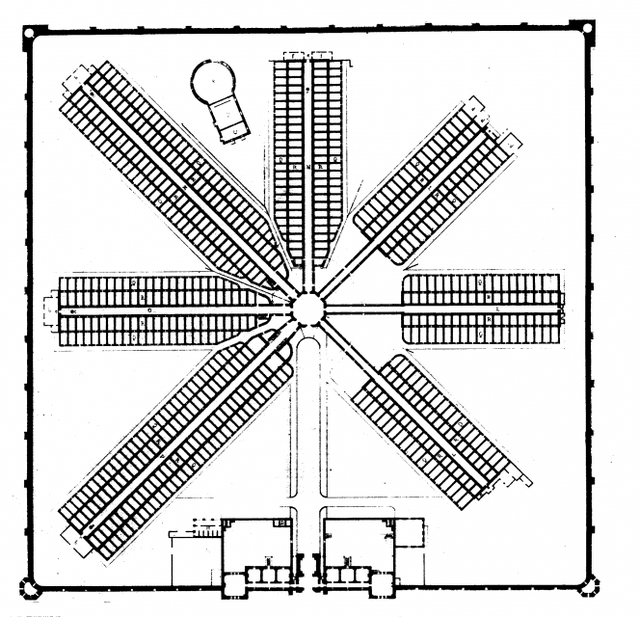
The radial plan, lopsided upon completion. Demetz and Bloet, 1836 Plan of Eastern State Penitentiary, 1837
As years passed, overcrowding caused wardens to cram structures into every available space behind the walls. The increased inmate population further compromised the Pennsylvania System, and finally, in 1913, the state officially ended its 84-year experiment in separate confinement. Eastern State Penitentiary awkwardly retrofitted to accommodate congregate workshops and dining halls.
The walled area meant to contain 266 prisoners held 1,648 in 1930. With more prisoners came more escape attempts, riots, and fights. Once famous for its optimistic reform principles, Eastern State added tommy guns to its arsenal in the 1920s and a death row in the 1950s.
Facta Non Verba. Deeds Not Words. This phrase is found imprinted on the curb by the baseball diamond, a makeshift space carved out for group recreation.
Artifacts from the prison include a number of shanks.
CK. 1938. A grinning face. These clues etched in mortar point us to Clarence “Kliney” Klinedinst, a skilled stone mason who did time at the penitentiary. Kliney was infamous for gaining the trust of the guards, establishing himself in the cell closest to the prison walls, then digging a 97-foot escape tunnel out to Fairmount Avenue. Bank robber Willie Sutton and a number of other prisoners joined him in this work. One of them wrote a poem about it entitled “The Leaking Pen.” It starts like this:
Twelve of the boys in the Eastern Pen,
Were serving their time that had no end;
When out of nowhere there appeared a hole
Which Kliney had dug—just like a mole.
As the poem describes it, Kliney dug through cave-ins and sewer stench and met a rascally rat named Waldo. At long last, on the morning of April 3, 1945, twelve prisoners burst out of the tunnel onto the city streets. The police recaptured six the same day: “More would have made it, but someone was peeking, / Who told the Warden that his jail was leaking.” In the end the escapees found themselves back at Eastern State, naked and shivering together in a punishment cell.
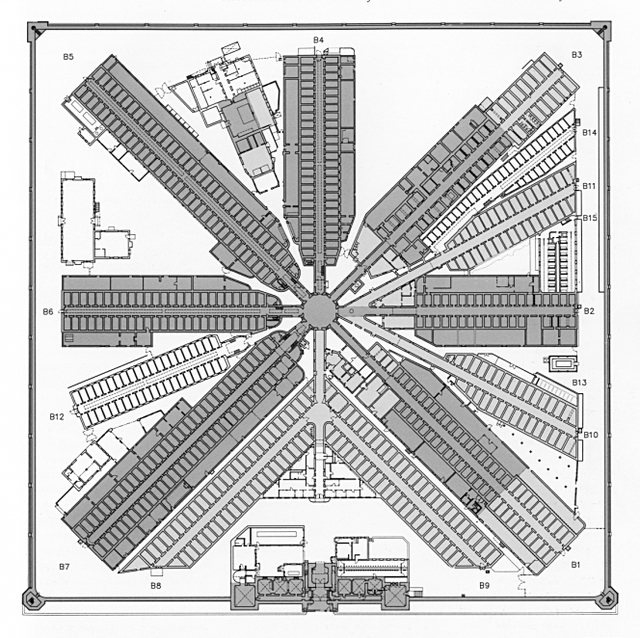
A 1971 plan of the prison shows structures filling in almost all the space. Eastern State Penitentiary Historic Site, 1971 Plan of Eastern State Penitentiary
Tour guides and mummified cats represent the two most recent strata of history. The cat we found probably lived and died sometime after 1971, when the last prisoner left Eastern State. I heard stories about those decades of abandonment: Gary the locksmith said he met vengeful ghosts who chased him right out of the building. Others talked of the heaps of junk that ended up inside the walls. Photos from the time show the prison overgrown, a jungle condensed into one city block. A colony of angry feral felines ruled the place, fed by a city caretaker known as Dan the Cat Man.
Developers called for demolition of the penitentiary: maybe leave the castle facade to preserve a bit of character, then turn the rest into restaurants, shops, or luxury condominiums. But instead, in 1988, the city handed Eastern State over to a preservation group. Maintained as a stabilized ruin, the prison opened for daily tours in 1994. It’s the rare historic site that tells a story of state failure. And at last the penitentiary has achieved massive success, not as a beacon of prison reform but as a sightseeing destination.
As for the mummified cat, it joined shanks and soap carvings in the historic site’s collection of artifacts. Recently it appeared on exhibit, resting on a red pillow under the words Felis catus. A dignified end.


